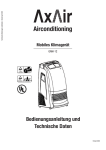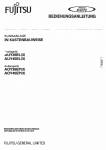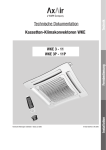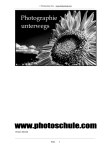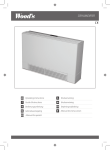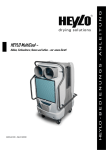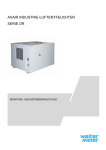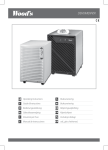Download Betriebsanleitung / Operating Instructions
Transcript
LuftentfeuchterRT310 29.01.2002 13:26 Uhr Seite 1 Barth + Stöcklein Luftentfeuchter RT 310 / Home-Driver Dehumidifier RT 310 Stand Januar 2002 Betriebsanleitung / Operating Instructions LuftentfeuchterRT310 29.01.2002 13:26 Uhr Seite 2 Betriebsanleitung Standort Diese Bedienungsanleitung enthält wichtige Angaben, die Sie benötigen, um von Ihrem neuen Luftentfeuchter den vollen Nutzen zu haben. Bitte lesen Sie die Anleitung aufmerksam, um das Gerät korrekt einzusetzen. Bewahren Sie diese Anleitung gut auf, da Sie sie vielleicht wieder zu einem späteren Zeitpunkt benötigen. Die von Ihrem Entfeuchter entzogene Menge an Feuchtigkeit hängt vom Standort und vom Feuchtigkeitsgrad Ihrer Wohnung ab. Auch Witterungsverhältnisse wirken auf die Leistungsfähigkeit des Entfeuchters. Diese wird z. B. bei sehr kaltem Wetter herabgesetzt. Ihr Entfeuchter kann in einem bestimmten Raum aufgestellt werden, wobei nur dieser Bereich entfeuchtet wird. Oder er kann z. B. auf dem Flur aufgestellt werden, um mehrere Räume gleichzeitig zu entfeuchten. Sicherheit Dieses Gerät wurde nach den geltenden Normen für Haushaltsgeräte hergestellt. Beim Aufstellen des Entfeuchters muß darauf geachtet werden, dass das Gerät auf einem ebenen Boden aufgestellt wird und genügend Abstand eingehalten wird, um die Luft ungehindert die Luftschlitze auf der Seite des Gerätes passieren lassen. Der Abstand zu angrenzenden Wänden oder Möbeln sollte mindestens 10 cm ausmachen, um die Leistungsfähigkeit des Gerätes nicht zu mindern. Der Kältekreislauf wurde auf Dichtheit überprüft. Das Gerät entspricht der EG-Richtlinie Nr. 82/499/EEC für Funkentstörung. Im hermetischen Verdichter befindet sich Öl, welches durch zu starkes Neigen (Transport) in die Leitungen gelangen und so zu Funktionsstörungen führen kann. Achten Sie bitte beim Transport darauf, dass das Gerät nicht zu stark gekippt wird und es nach dem Transport mindestens 1 Stunde nicht eingesteckt wird. Der Entfeuchter sollte nicht in der Nähe von Heizkörpern oder anderen Wärmequellen oder direktem Sonnenlicht aufgestellt werden, da die Leistungsfähigkeit beeinträchtigt wäre. Wir raten davon ab, Vasen oder andere mit Wasser gefüllte Behälter auf dem Entfeuchter abzustellen. Eventuell verschüttetes Wasser beeinträchtigt die Bedienung und die Sicherheit des Gerätes. Beim Einsatz in der Nähe von Schwimmbecken muß das Gerät fest montiert werden. Wenn Sie den Standort des Gerätes wechseln möchten, schalten Sie es vorher am Ein/Aus-Schalter aus und entleeren Sie den Wasserbehälter. Außerdem empfehlen wir, das Gerät über einen FI-Schutzschalter zu sichern. Während des Betriebs müssen Türen und Fenster möglichst geschlossen bleiben. Einleitung Kein Haushaltsentfeuchter kann die Feuchtigkeit aus Ihrer Wohnung völlig entfernen. Der RT 310 reduziert aber die Feuchtigkeit erheblich, um Feuchteschäden an Wänden und Mobiliar verhindern. Der Zeitraum der zum Reduzieren der Feuchtigkeit erforderlich ist, kann variieren. Er ist vom Rauminhalt, dem Feuchtigkeitsgehalt und der Außentemperatur (d. h. der Jahreszeit) abhängig. Bereits im Laufe einiger Tage werden Sie einen kontinuierlichen Rückgang der Feuchtigkeit feststellen. Es kann aber bis zu mehreren Wochen dauern, bis die Feuchtigkeit auf ein akzeptables Niveau reduziert ist. Feuchtigkeit ist in vielen Wohnungen ein ernstes Problem. Feuchtigkeit entsteht, wenn der Wasserdampf der Luft mit einer kalten Fläche in Kontakt kommt. Bei Abkühlung des Wasserdampfes findet eine Kondensation statt, wodurch sich Wassertropfen bilden. Feuchtigkeit bildet sich auf jeder kalten Fläche im Haus, wie zum Beispiel auf Fenstern, Wänden, Decken und Möbeln. Wenn viel Feuchte entsteht, sind Beschädigung und Verfärbung der Innenausstattung die Folge. Es bildet sich Schimmel. Hohe Feuchtigkeit schadet auch den Menschen, in schweren Fällen können Krankheiten entstehen. Stromanschluß Durch einen leistungsfähigen Entfeuchter läßt sich die Feuchtigkeit beseitigen oder auf ein Minimum (max. 45% r. F.) reduzieren. Der RT 310 wird an 230 V/50 Hz angeschlossen. Arbeitsweise Der Entfeuchter entzieht der Raumluft die Feuchte, indem die Luft über Kühlschlangen geführt wird. Durch Abkühlen der Luft kondensiert Wasserdampf zu kleinen Wassertropefen, die in einem Behälter aufgefangen werden. dieser Behälter muß, wenn nötig entleert werden. 2 LuftentfeuchterRT310 29.01.2002 13:26 Uhr Seite 3 Bedienungspanel Bedienung des Hygrostaten Sie können mit dem Hygrostat die von Ihnen gewünschte relative Feuchtigkeit wählen. Das Gerät läuft dann, bis das eingestellte Niveau erreicht ist, und schaltet dann ab. Je weiter Sie den Hygrostat-Drehknopf nach rechts drehen, desto niedriger ist der eingestellte Feuchtwert. Zu Ihrer Information: Menschen fühlen sich bei 20 bis 22°C und bei einer relativen Luftfeuchtigkeit von 45 bis 55% am wohlsten. Die genaue Einstellung für Ihr Wohlbefinden wird je nach Temperatur variieren und davon abhängen, wann Sie sich persönlich am wohlsten fühlen. Hinweis Schaltet Ihr Entfeuchter aus, obwohl die Luftfeuchtigkeit noch immer sehr hoch ist, kann es darauf zurückzuführen sein, daß der Hygrostat zu niedrig eingestellt wurde (zu weit nach links). Ventilator Position I niedrige Ventilatorgeschwindigkeit Position II hohe Ventilatorgeschwindigkeit Umgekehrt gilt: Ist die Feuchtigkeit im Raum genügend reduziert und das Gerät läuft immer noch, dann ist die Einstellung vielleicht zu hoch (zu weit nach rechts) und muß niedriger eingestellt werden. Füllanzeige des Wasserbehälters Die Lampe leuchtet, wenn der Wasserbehälter voll ist. Der Entfeuchter schaltet dann automatisch ab. Die Lampe leuchtet auch, wenn der Wasserbehälter entfernt ist. Abtauen Ein/Aus-Schalter Das Abtauen erfolgt automatisch. Der Kompressor schaltet sich ab. Durch einen Zeitautomat jede Stunde für 6 min. Das Gebläse bleibt in Betrieb. Der Kompressor schaltet sich nach dem Abtauvorgang selbständig wieder ein. Position I Der Entfeuchter ist eingeschaltet. Position 0 Der Entfeuchter ist ausgeschaltet. Hygrostat-Drehknopf Entleerung des Wasserbehälters Zur Einstellung der gewünschten Luftfeuchte (12-70% r.F.). Wenn das Gerät entfeuchtet, wird Wasser im Sammelbehälter aufgefangen. Ist der Wasserbehälter voll, schaltet der Entfeuchter automatisch ab und die rote Lampe am Schaltpanel leuchtet auf. Der Behälter muß jetzt entleert werden. Nach links hohe Feuchtigkeit (70%) Nach rechts niedrige Feuchtigkeit (12%) Bedienung des Entfeuchters Hierzu schalten Sie das Gerät am Ein/Aus-Schalter ab, nehmen den Behälter heraus und entleeren ihn. Nach der Entleerung den Behälter wieder ins Gerät einsetzen (eventuell verschüttetes Wasser im Gerät sollte zuerst aufgewischt werden) und den Entfeuchter wieder einschalten. Achten Sie darauf, dass der Ein/Aus-Schalter auf Pos. 0 und der Ventilatorschalter in Pos. II (hohe Geschwindigkeit) steht. Der Hygrostat-Drehknopf muß ganz nach rechts gedreht sein. Stecken Sie den Stecker in die Steckdose und betätigen Sie den Ein/AusSchalter. Der Entfeuchter beginnt zu arbeiten. Permanenter Wasseranschluss an Ablauf Ihr Entfeuchter ist mit einem regulierbaren Hygrostat versehen, der das Gerät automatisch ausschaltet, wenn die eingestellte relative Feuchtigkeit im Raum erreicht ist, und es wieder einschaltet, wenn die Feuchtigkeit steigt. Wenn der Luftentfeuchter unter Verhältnissen mit einer sehr hohen Feuchtigkeit eingesetzt wird, wird es notwendig sein, den Behälter regelmäßig zu entleeren. Um das zu vermeiden, kann ein Schlauch von passender Länge auf den Schlauchstutzen am Behälter montiert werden. Nach Demontage des Pfropfen am Behälter wird der Schlauch montiert und in einen Ablauf geleitet. Der Pfropfen kann wieder montiert werden. Links am Schaltpanel befindet sich der Ventilatorschalter, der es Ihnen ermöglicht, zwischen hoher und niedriger Ventilatorgeschwindigkeit zu wählen. Wenn möglich, sollte immer die hohe Geschwindigkeit (Pos. II) benutzt werden, da dadurch die maximale Entfeuchtung erzielt wird und das Risiko einer Vereisung der Kühlspiralen gemindert wird. Die niedrige Geschwindigkeit (Pos. I) sollte nur benutzt werden, wenn der Geräuschpegel zu hoch ist. 3 LuftentfeuchterRT310 29.01.2002 13:26 Uhr Seite 4 Technische Daten Hinweis Der Ablaufschlauch muß mit einem stetigen Gefälle verlegt werden und immer unter dem Niveau des Entfeuchters enden. Es darf keine Windungen oder andere Hindernisse am Schlauch geben, die den Ablauf des Wasser beeinträchtigen könnten. Achten Sie darauf, dass bei kaltem Wetter der Schlauch nicht zufriert und den Abfluss blockiert. Breite 30 cm Höhe 56 cm Tiefe 34 cm Gewicht ca. 23 kg Reinigung des Luftfilters Spannung 230 V Stromaufnahme bei 20°C 260 W Der Entfeuchter ist mit einem Luftfilter ausgestattet, der regelmäßig (z. B. einmal die Woche) gereinigt werden muß. Wenn der Filter verschmutzt ist, wird die Leistung des Gerätes wesentlich beeinträchtigt. Feuchtigkeitsbereich (einstellbar) 12 - 70% r.F. Temperaturbereich 5 - 32°C Wasserbehälter 6 Liter Entfeuchtungsleistung*: Zur Reinigung des Filters muß der Entfeuchter ausgeschaltet sein. Die Klinke (hinten über dem Wasserbehälter plaziert) dann ein wenig nach rechts drücken, den Filter herausziehen und reinigen (z. B. mit einem Staubsauger). Der Filter wird wieder eingesetzt, indem er die Seite entlang aufwärts geführt wird, bis ein Klicken zu hören ist. Der Entfeuchter ist nun wieder betriebsbereit. bei 12°C, 70% r.F. 3,0 Liter/Tag bei 20°C, 60% r.F. 5,0 Liter/Tag bei 27°C, 60% r.F. 7,0 Liter/Tag bei 32°C, 80% r.F. 12,0 Liter/Tag * bei hoher Ventilatorgeschwindigkeit Betriebsstörungen Schematischer Aufbau Bevor Sie den Kundendienst rufen, überprüfen Sie bitte: • dass der Stecker richtig in der Steckdose sitzt und der Strom eingeschaltet ist • dass das Gerät am Ein/Aus-Schalter eingeschaltet ist (die Lampe leuchtet) • dass der Wasserbehälter nicht voll ist (die rote Lampe leuchtet) und dass er richtig angebracht ist • dass der Hygrostat richtig eingestellt ist. Sicherheit • Das Gerät darf nur für den vorgesehenen Zweck benutzt werden. • Das Gerät ist nur für den Gebrauch im Haushalt vorgesehen. • Bei Service und Wartung darf die Außenverkleidung (Gehäuse) ausschließlich von qualifizierten Fachleuten entfernt werden. • Vasen und Behälter mit Wasser dürfen nicht auf dem Entfeuchter abgestellt werden. Technische Änderungen vorbehalten. 4 LuftentfeuchterRT310 29.01.2002 13:26 Uhr Seite 5 Operating instructions Positioning your dehumidifier This booklet contains the information you will require to understand and operate your new dehumidifier. It is worth while spending a little time reading your instructions so you will understand fully how to operate the appliance. Please keep this booklet handy – you may want to refer to it at a later date. The amount of moisture removed by your dehumidifier will vary depending upon the location and the severity of dampness within your home. Weather conditions will also affect the performance of the dehumidifier: for example in very cold weather the performance will be reduced. Your dehumidifier may be positioned in a single room allowing it to concentrate in a specific area or alternatively it can be positioned centrally within a large area for example in a hall way to reduce the level of humidity from more than one room at the same time. Warning This dehumidifier was built according to the regulations for electrical household machines. When positioning your dehumidifier ensure that it is placed on a level surface and there is adequate spacing for air to flow through the side vents of the unit. A minimum distance of 10 cm should be allowed from any adjacent wall or furniture so as not to cause obstruction which may reduce the performance. The dehumidifier should not be placed near to radiators or any other heat source or in direct sunlight as this would reduce the performance. The refrigerant circuit has been proofed for leakage. The unit has been proofed too, for EG regulations Nr. 82/499/EEC. The compressor is filled with oil, during transportation with an angle >45° this oil could move inside the circuit. To prevent any damage of the unit during the first start, the unit should not immediately run after transportation. We do not recommend that vases or any other vessels containing water be placed on the dehumidifier as water spillage would be detrimental to the operation and safety of the appliance. If you wish to move the dehumidifier it should be switched off at the on/off switch and the water tank emptied. Please wait for 1 hour after transportation befor you start the unit. If the unit should be positioned near to a swimming pool, please install the unit fixed on a wall. When the dehumidifier is on operation windows and doors should only be opened when necessary. This will prevent dehumidified air being lost to the outside atmosphere and being replaced with moist air. It should be noted that no domestic dehumidifier is capable of completely eliminating condensation from your home, but your dehumidifier will significantly reduce condensation and prevent damp and mould growth in your home and damage to soft furnishings. Futhermore, for safety we recommend to use an FI-protection switch. Introduction Condensation has become a major problem in many homes. Condensation is formed as a result of water vapour in the air coming into contact with a cool surface. As the water vapour is cooled it starts to condense and forms into droplets of water. Condensation will form on any cool surface within the home, for example: windows, walls, ceilings and soft furnishings. If the condensation is left to accumulate it can cause deterioration of discolouration to decor and soft furnishings and in more severe conditions mould can grow. High levels of humidity can also affect human beings causing discomfort and in severe cases illness may occur. With the use of an effective dehumidifier the humidity of the air can be removed or reduced to an acceptable level. The operating time to reduce moisture can vary dependent on the area, the level of moisture and the weather temperature (i.e. the time of year). You should start to notice a reduction in condensation within a few days of operation but it may take up to several weeks to completely remove moisture to an acceptable lavel. Electrical connection Your dehumidifier requires an electrical supply of 230 volts - 50 cycles. How a dehumidiefier works A dehumidifier extracts moisture from the air in your home by passing the air over cooling coils. As the air ist cooled the water vapour in the air is condensed to water droplets which are then collected in a collecting tank in the dehumidifier. This tank can then be emptied when required. 5 LuftentfeuchterRT310 29.01.2002 13:26 Uhr Seite 6 Control panel Operating the variable humidity control You can select the level of relative humidity you require and the appliance will operate until the preset level has been achieved at which time the dehumidifier will switch off. As a guide to operation - the higher the setting the lower the relative humidity level will be before the appliance switches off; therefore the appliance will operate longer. For your guidance in setting the humidistat people are most comfortable at 20°C to 22°C at a relative humidity of 45% to 55%. The correct setting for your own personal preference. Please note: If your dehumidifier switches off an condensation is still present, you may find that the humidistat is set too low (too far to the left). Conversely if condensation has been removed from the room and the appliance still operates, the setting may be too high (too far to the right) and should be set at a lower position. Pos. -Fan In Position I: In Position II: low speed high speed Defrosting Pos. -Red lamp: The lamp is on when the water tank is full. The lamp is on when the water tank has been removed. The dehumidifier is defrosted automatically. The compressor stops for a few minutes every hour. The fan continues to operate. Pos. -On/off-switch: In Position I: In Position 0: the dehumidifier is operating. the dehumidifier stops operating. Emptying the water tank Pos. -Twist knob: As the dehumidifier operates water will be collected in a tank fitted within the appliance. As the tank becomes full the dehumidifier will automatically switch off and the red lamp on the control panel will glow indicating that the tank is full an requires emptying. Humidistat for the setting of the wanted humidiy (from 12-70% rh). To the left: To the right: high humidity (70%) low humidity (12%) To empty the tank: switch off the dehumidifier by pressing the on/off switch, take out the tank and empty it. How to operate your dehumidifier Replace the tank (wipe any water spillage from the water tank housing first) an switch on the dehumidifier. Starting your dehumidifier: ensure that the on/off switch (see control panel) is switched off, that the change-over switch is set at position II (high speed), and the humidistat is turned completely to the right. Insert the plug and switch on at the mains switch. Press the on/off switch so that the dehumidifier starts operating. The lamp in the on/off switch will switch on at the same time, which indicates that the dehumidifier is under tension. Your dehumidifier is fitted with an adjustable humidistat to automatically switch off the unit when the preset relative humidity in the room ist reached an switch the appliance back on again when it increases. The dehumidifier is fitted with a change-over switch to the left on the control panel, by which it is possible to change between high and low fan speed. Wherever possible, you should always use the high speed (pos. II), as this gives the largest dehumidification and less risk of ice formation on the cooling coils. The low speed (pos. I) is only to be used when the noise is annoying. Permanent draining option If the dehumidifier is operated in situations with very high humidity levels the tank may require emptying on a regular basis. To avoid this inconvenience a suitable length of flexible hose can be fixed to the outlet connection on the tank. The hose is mounted and led to a drain after dismounting the plug on the tank. The plug can be mounted again. 6 LuftentfeuchterRT310 29.01.2002 13:26 Uhr Seite 7 Technical data Please note: The outlet hose must at all times be positioned at a lower level than the dehumidifier and must have no kinks or other obstructions which may reduce the flow of discharge water from the appliance. It should be noted that in severe weather conditions precautions should be observed to avoid the pipe freezing and blocking the discharge. Width 30 cm Height 56 cm Depth 34 cm Weight approx. 23 kg Cleaning the filter Voltage 230 V Connected load at 20°C 260 W The dehumidifier is fitted with an air filter which should be cleaned on a regular basis (i.e. once a week). If the filter should become dirty, the capacity of the dehumidifier will be considerably reduced. To clean the filter: switch off the dehumidifier at the on/off switch. By pushing the catch a little to the right (placed at the back above the water tank), the filter can be pulled down and removed. Clean/vacuum-clean the filter. Replace the filter by pushing it up along the side until a „click“ is heard. The dehumidifier is ready to operate again. Range of humidity 12 - 70% rh Operating temperature 5 - 32°C Water capacity 6 litres If your dehumidifier should fail to operate * at high fan speed Before calling for assistance please check the following points: Identification diagramm Capacity liters/day*: • Check that the mains plug is fully connected to the socket and the socket is switched on. • That the appliance is switched on at the on/off switch on the control panel (the lamp is on). • Check that the water tank is not full or is placed correctly (the red lamp is on). • Check that the setting of the humidistat is correct. For your safety • The product should only be used for its intended pur pose. • The product is intended for indoor use only. • Under no circumstances should external covers be removed for servicing or maintenance except by suitably qualified personnel. We reserve the right to change specifications without prior notice. 7 12°C, 70% rh 3,0 liters/day 20°C, 60% rh 5,0 liters/day 27°C, 60% rh 7,0 liters/day 32°C, 80% rh 12,0 liters/day LuftentfeuchterRT310 29.01.2002 13:26 Uhr Seite 8 Axair GmbH Systeme für die Luftkonditionierung & Co. KG Ein WMH Unternehmen Stammhaus München: 85748 Garching-Hochbrück, Carl-von-Linde-Str. 25, Tel. 089/32670-0, Fax 089/32670-140, e-mail: [email protected], www.axair.de, www.klimaplus.de Regionalcenter Süd Regionalcenter Südwest Regionalcenter Mitte Regionalcenter West Regionalcenter Nord Regionalcenter Ost 85748 München 90614 Ammerndorf 70563 Stuttgart 63069 Offenbach 40235 Düsseldorf 30625 Hannover 10829 Berlin Carl-von-Linde-Str. 25 Holunderweg 5 Waldburgstr. 17-19 Senefelderstr. 164 Hoffeldstr. 85 Misburger Str. 89 Gotenstr. 82 Tel. 089/3 26 70-0 Tel. 09127/5 70 91-0 Tel. 0711/78 87 94-3 Tel. 069/984040-0 Tel. 0211/69 07 57-0 Tel. 0511/56 35 97-70 Tel. 030/556709-0 Fax 089/3 26 70-140 Fax 09127/5 70 91-11 Fax 0711/78 87 94-48 Fax 069/984040-40 Fax 0211/69 07 57-50 Fax 0511/563401 Fax 030/556709-11








